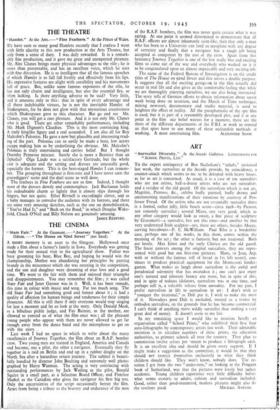THE CINEMA
"State Fair." At the Gaumont.—"Journey Together." At the Odeon.—" The House on 92nd Street" (not fixed).
A SHORT memory is an asset to the filmgoer. Hollywood once made a film about a farmer's family in Iowa. Everybody was getting ready for their annual visit to the agricultural show. Father was busy grooming his boar, Blue Boy, and hoping he would win the championship, Mother was abandoning her principles by putting brandy in the mincemeat which she was entering in the competition, and the son and daughter were dreaming of true love and a good time. We went to the fair with them and enjoyed their triumphs and disappointments. You may remember the film ; it was called State Fair and Janet Gaynor was in it. Well, it has been remade, this time in colour with music and song. Far too much song. The old State Fair had something good and honest about it it had a quality of affection for human beings and tenderness for their simple pleasures. All this is still there if only everyone would stop singing for just a moment and let us look at. the story. Only Donald Meek, as a bibulous pickle judge and Fay Bainter, as the mother, are allowed to remind us of what the film once was • all the pleasant young people who appear with them are never allowed to get far enough away from the dance band and the microphone to get on with the story. .
Last week I had no space in which to write about the many excellencies of Journey Together, the film about an R.A.F. bomber crew. Two young men are trained in England, America and Canada and become, one a pilot, the other a navigator. Eventually they fly together in a raid on Berlin and end up in a rubber dinghy on the North Sea after a hazardous return journey. The subject is beauti- fully handled by director John Boulting and extremely well photo- graphed by Harry Waxman. The acting is very convincing with outstanding performances by Jack Watling as the pilot, Ronald Squire in a small part, as a Selection Board Officer, and Fletcher Markel as the Canadian who gives the navigator his first big test. Only the uncertainties of the script occasionally betray the film. Apart from being a tribute to the bravery and endurance of the men of the R.A.F. bombers, the film was never quite certain what it was saying. At one point it seemed determined to demonstrate that all R.A.F. officers are almost inhumanly saint-like, then that only a man who has been to a University can land an aeroplane with any degree of certainty and finally that a navigator has a tough job being accepted as competent by the rest of the crew. Apart from this hesitancy Journey Together is one of the few really fine and exciting films to come out of the war and everybody who worked on it is to be congratulated upon an almost impeccable and very exciting job. The name of the Federal Bureau of Investigation is on the credit titles of The House on 92nd Street and this serves a double purpose. It suggests that all the exciting goings-on in the film actually did occur in real life and also gives us the comfortable feeling that while we are thoroughly enjoying ourselves, we are also being instructed. The story tells of German efforts to obtain information about secret work being done on uranium, and the March of Time technique, mixing newsreel, documentary and studio material, is used to heighten the effect of reality. All the paraphernalia of the spy film is used, but it is part of a reasonably developed plot, and if at any point in the film our belief wavers for a moment, there are the shots of the different departments of the F.B.I. at work to remind us that spies have to use many of these outlandish methods of
working. A most entertaining film. ALEXANDER SHAW.


























 Previous page
Previous page